Picture this: you’re craving something warm, aromatic, and deeply satisfying—the kind of meal that fills your kitchen with incredible smells and your belly with comfort. That’s the magic of curry paste! Whether you’re a weeknight warrior or a weekend foodie, these 20 delicious curry paste recipes are about to become your new go-tos for easy, flavor-packed dinners. Ready to spice things up? Let’s dive in!
Classic Thai Red Curry Paste
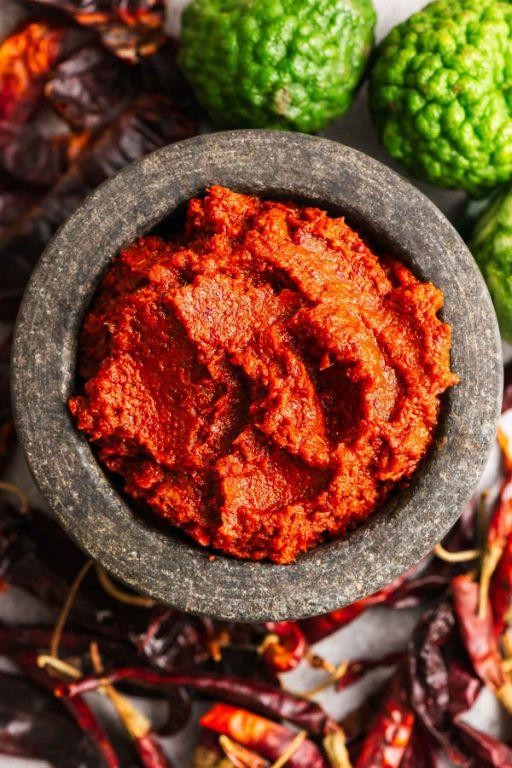
Folding back the pages of my well-worn cooking journal, I remember the first time I attempted to make this paste—the aromatic steam rising from my mortar felt like unlocking a secret. There’s something grounding about preparing it from scratch, a quiet ritual that connects hands to heart.
Ingredients
– 10 dried red chilies, stems removed (I like to soak these in warm water for 20 minutes to soften them, making grinding easier)
– 4 cloves garlic, peeled (fresh, firm cloves are my go-to for the brightest flavor)
– 1 small shallot, roughly chopped (about ¼ cup—I find shallots sweeter and milder than onions here)
– 1 stalk lemongrass, tender white part only, thinly sliced (about 2 tablespoons)
– 1 teaspoon galangal, finely grated (fresh galangal is worth seeking out for its citrusy punch)
– 1 teaspoon coriander seeds, toasted (toasting in a dry pan for 2–3 minutes until fragrant deepens their nuttiness)
– ½ teaspoon cumin seeds
– ½ teaspoon white peppercorns
– ¼ teaspoon shrimp paste (I wrap mine in foil before toasting to contain the strong aroma)
– 1 tablespoon vegetable oil
Instructions
1. Place the dried red chilies in a small bowl and cover with warm water; let them soak for 20 minutes until softened.
2. Toast the coriander seeds, cumin seeds, and white peppercorns in a dry skillet over medium heat for 2–3 minutes, shaking the pan frequently, until they release a nutty aroma.
3. Wrap the shrimp paste tightly in a small piece of aluminum foil and toast it in the same skillet for 1 minute per side to mellow its sharpness.
4. Drain the soaked chilies and pat them dry with a paper towel to remove excess moisture.
5. Combine the soaked chilies, toasted spices, shrimp paste, garlic, shallot, lemongrass, and galangal in a mortar or food processor.
6. Grind or pulse the mixture for 5–7 minutes, scraping down the sides as needed, until it forms a coarse, textured paste. (Tip: If using a mortar, use a circular grinding motion to release the oils gradually.)
7. Heat 1 tablespoon of vegetable oil in a small pan over medium-low heat until it shimmers, about 2 minutes.
8. Add the paste to the pan and fry for 5–7 minutes, stirring constantly, until it darkens slightly and becomes highly fragrant. (Tip: Keep the heat low to avoid burning the delicate spices.)
9. Remove the pan from the heat and let the paste cool completely to room temperature, about 15 minutes. (Tip: Cooling it fully before storing prevents condensation in the container.)
Vibrant and deeply aromatic, this paste carries the warmth of toasted spices and the bright kick of fresh aromatics. Its coarse texture clings beautifully to proteins or vegetables, infusing them with layers of flavor. Try stirring a spoonful into coconut milk for a quick curry, or mix it with yogurt as a marinade for grilled chicken.
Spicy Indian Vindaloo Paste
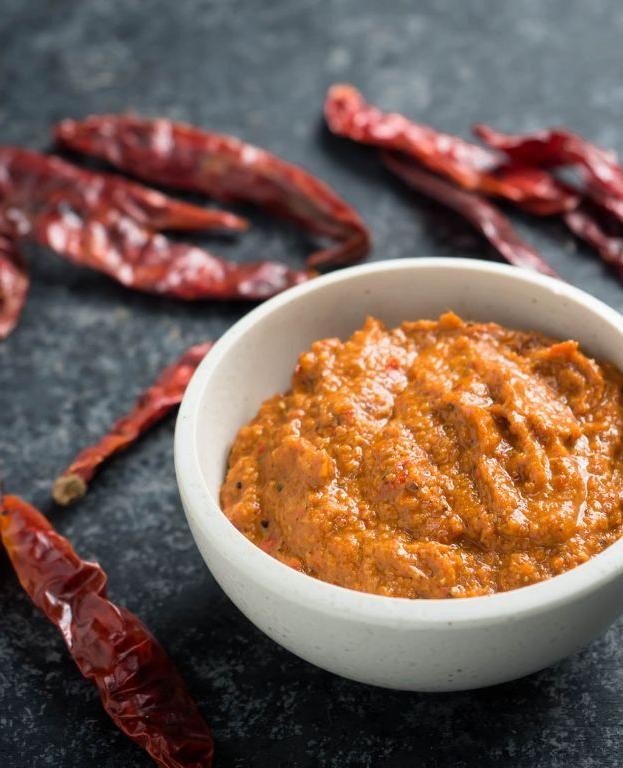
Just yesterday, I found myself standing before my spice cabinet, the earthy aromas of cumin and coriander transporting me back to that tiny Goa restaurant where I first fell in love with vindaloo. Sometimes the most complex flavors begin with the simplest moments of kitchen contemplation.
Ingredients
– 1/2 cup apple cider vinegar (I love its fruity tang here)
– 1/4 cup extra virgin olive oil (my trusty Mediterranean staple)
– 8 dried Kashmiri chilies (their vibrant red hue always delights me)
– 1 tablespoon cumin seeds (toasting them releases such warmth)
– 2 teaspoons black peppercorns (freshly cracked makes all the difference)
– 1 teaspoon fenugreek seeds (their maple-like scent fills my kitchen)
– 6 garlic cloves (I always choose plump, firm ones)
– 1 inch fresh ginger (peeled and roughly chopped)
– 1 teaspoon turmeric powder (this golden spice stains my wooden spoon beautifully)
– 1/2 teaspoon cinnamon (just a whisper transforms everything)
Instructions
1. Place dried Kashmiri chilies in a small bowl and cover completely with hot water, letting them soak for 20 minutes until pliable.
2. While chilies soak, heat a dry skillet over medium heat for 2 minutes until warm to the touch.
3. Add cumin seeds, black peppercorns, and fenugreek seeds to the skillet, toasting for 90 seconds until fragrant and slightly darkened.
4. Transfer toasted spices to a spice grinder and pulse 5 times until coarsely ground.
5. Drain soaked chilies, discarding the soaking water completely.
6. Combine soaked chilies, ground spices, garlic cloves, ginger, turmeric, and cinnamon in a blender.
7. Pour apple cider vinegar and olive oil over the ingredients in the blender.
8. Blend on high speed for 2 minutes, scraping down the sides once, until a smooth paste forms.
9. Transfer the paste to a clean glass jar, pressing down to remove air pockets.
10. Refrigerate the sealed jar for 24 hours before using to allow flavors to meld. Creating this paste feels like capturing sunlight in a jar—the fiery chilies mellow into warmth while the spices weave together into something greater than their parts. Consider swirling a spoonful into coconut milk for a quick curry or marinating chicken overnight for that deep, penetrating heat that makes vindaloo so unforgettable.
Aromatic Massaman Curry Paste
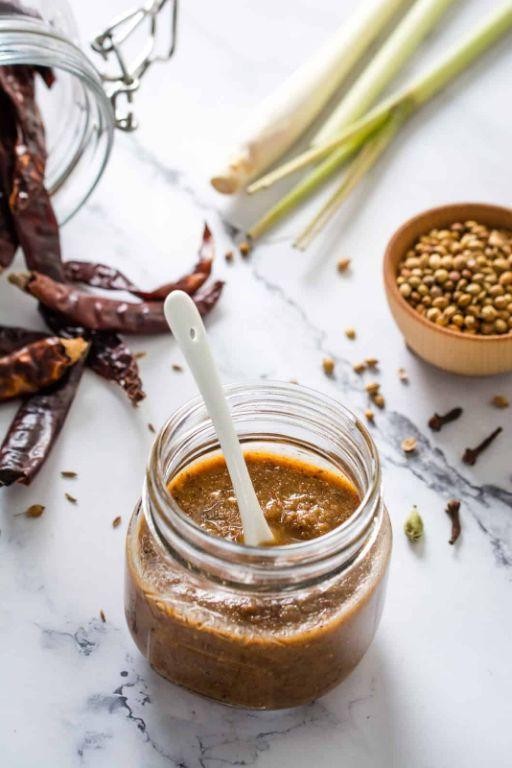
Zestful memories of bustling Bangkok markets come drifting back whenever I make this curry paste from scratch—the earthy scent of toasted spices filling my kitchen feels like wrapping myself in a warm, fragrant blanket on a quiet afternoon.
Ingredients
– 1/2 cup dried red chilies (I like to use a mix of guajillo and ancho for layered heat)
– 1/4 cup raw peanuts (toasting them first makes all the difference)
– 3 tbsp coriander seeds (freshly toasted releases their citrusy notes)
– 2 tbsp cumin seeds (their earthy warmth is essential)
– 1 tsp whole cloves (just a whisper—they’re potent)
– 1/2 tsp cardamom pods (I crush them lightly to open the shells)
– 1 cinnamon stick, broken into pieces (Ceylon cinnamon has a softer flavor)
– 1/4 cup chopped shallots (they caramelize so beautifully)
– 3 garlic cloves (fresh and firm, please)
– 1 tbsp chopped lemongrass (the tender inner stalk only)
– 1 tsp grated galangal (frozen works wonderfully if fresh isn’t available)
– 1/2 cup coconut cream (the thick part from the top of the can)
– 2 tbsp fish sauce (this is my preferred brand for balanced saltiness)
Instructions
1. Heat a dry skillet over medium-low heat for 2 minutes until warm to the touch.
2. Add dried red chilies and toast for 45 seconds per side until fragrant but not burnt.
3. Transfer chilies to a bowl and cover with hot water to soak for 15 minutes until pliable.
4. In the same skillet, toast raw peanuts for 3 minutes, shaking frequently until golden.
5. Add coriander seeds, cumin seeds, cloves, cardamom pods, and cinnamon pieces to the skillet.
6. Toast spices for 90 seconds until the coriander seeds turn a shade darker and release their aroma.
7. Drain soaked chilies, discarding the water, and place them in a blender.
8. Add toasted peanuts and all toasted spices to the blender.
9. Add chopped shallots, garlic cloves, lemongrass, and grated galangal to the blender.
10. Pour in coconut cream and fish sauce.
11. Blend on high speed for 2 minutes, scraping down the sides twice, until a smooth paste forms.
12. Transfer paste to an airtight jar, pressing it down to remove air pockets.
13. Refrigerate immediately where it will keep for 2 weeks.
Hearty and complex, this paste transforms when simmered—the peanuts lend a subtle creaminess while the spices bloom into warmth that lingers. I love swirling a spoonful into coconut milk with potatoes and chicken, but it’s equally wonderful as a marinade for grilled eggplant, where its aromatic depth really shines.
Zesty Green Curry Paste
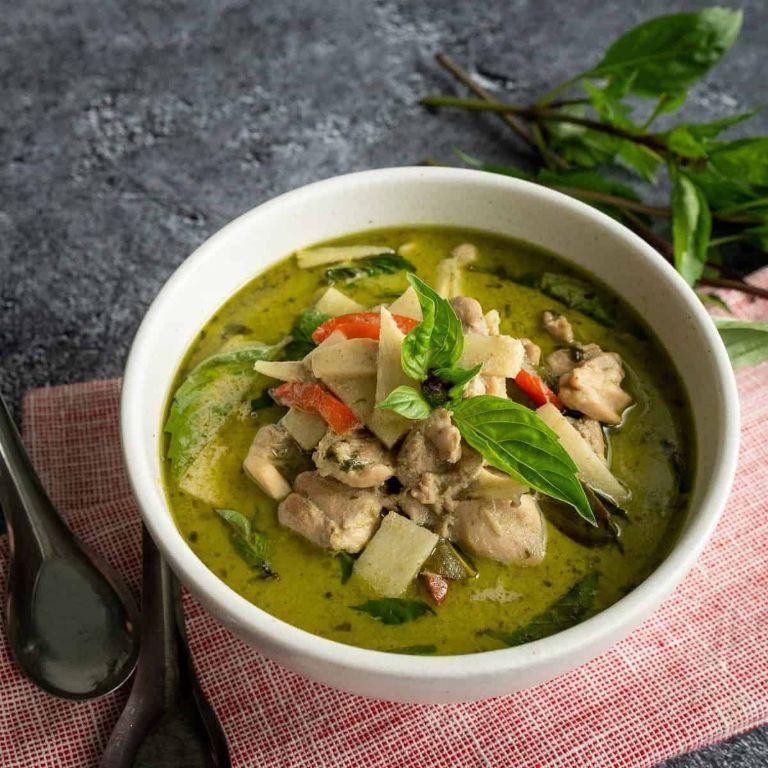
Venturing into the quiet kitchen this morning, I found myself drawn to the vibrant greens waiting on the counter, their colors promising something both comforting and alive. There’s a particular magic in making curry paste from scratch—the way each ingredient releases its story into the mortar, creating something greater than the sum of its parts. It feels like a small, mindful ritual, transforming simple components into the heart of countless meals to come.
Ingredients
– 1 cup fresh cilantro stems, packed (I save the leaves for garnish—their stems hold such bright, earthy flavor)
– 4 medium green chilies, stems removed (I like serranos for their balanced heat, but jalapeños work beautifully too)
– 3 cloves garlic, peeled (fresh, firm cloves make all the difference here)
– 1 tablespoon fresh lime juice (I always squeeze it right before using—it keeps that zesty punch intact)
– 1 teaspoon ground cumin (toasting it lightly first deepens its warmth)
– 1/2 cup coconut milk (full-fat gives the paste a lovely, creamy richness)
– 1/4 cup chopped lemongrass, tender inner parts only (I find freezing the stalks makes them easier to mince finely)
– 2 tablespoons vegetable oil (a neutral oil lets the other flavors shine through)
Instructions
1. Roughly chop the cilantro stems, green chilies, garlic, and lemongrass into small, uniform pieces to help them break down evenly in the blender.
2. Combine all chopped ingredients, lime juice, ground cumin, and coconut milk in a high-speed blender.
3. Blend on high speed for 45 seconds, stopping once to scrape down the sides with a spatula, until the mixture forms a smooth, vibrant green paste with no visible chunks.
4. Heat the vegetable oil in a small skillet over medium heat until it shimmers, about 2 minutes.
5. Add the blended paste to the hot oil and cook for 5 minutes, stirring constantly with a wooden spoon, until the raw garlic smell fades and the paste darkens slightly.
6. Remove the skillet from heat and let the paste cool completely to room temperature, about 20 minutes, before transferring it to an airtight jar. What emerges is a paste that’s both velvety and flecked with texture, carrying the bright kick of lime and chili mellowed by coconut’s creaminess. Wrapped around roasted vegetables or stirred into simmering broth, it becomes an instant anchor for weeknight dinners, its layers unfolding gently with each spoonful.
Rich Panang Curry Paste
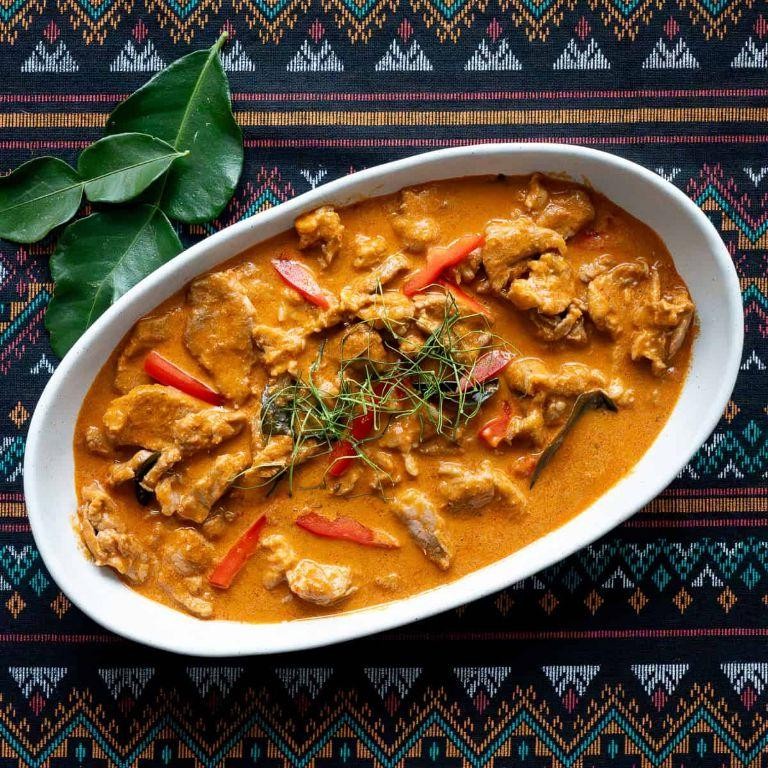
A quiet afternoon finds me reaching for the mortar and pestle, that familiar weight in my hands promising something deeply comforting and rich. There’s something almost meditative about building a curry paste from scratch, toasting each spice until its fragrance fills the kitchen. This Panang curry paste, with its layers of warmth and subtle sweetness, feels like a slow, deliberate hug in a bowl.
Ingredients
– 4 dried red chilies, stems removed—I like to use a mix of guajillo and ancho for a deep, smoky heat rather than just pure fire.
– 1 tablespoon coriander seeds, which I always buy whole and toast fresh for the brightest flavor.
– 1 teaspoon cumin seeds—toasting these just until they pop releases their earthy, nutty soul.
– 1/2 teaspoon white peppercorns, for a cleaner, sharper heat than black pepper provides.
– 3 cloves garlic, smashed—I find smashed cloves release their oils more readily than minced.
– 1 small shallot, roughly chopped; its subtle sweetness balances the heat so beautifully.
– 1 stalk lemongrass, tender white part only, thinly sliced—don’t skip the bruising step, it makes all the difference.
– 1 teaspoon makrut lime zest, finely grated; I keep a bag in the freezer for moments like this.
– 1/2 inch piece of galangal, peeled and sliced—its piney, sharp flavor is irreplaceable, ginger just won’t do.
– 1 tablespoon roasted peanuts, unsalted; I toast a big batch on Sundays to have on hand.
– 1/2 teaspoon shrimp paste, wrapped tightly in foil—toasting it mellows its pungent edge into something deeply savory.
Instructions
1. Heat a dry skillet over medium-low heat for 2 minutes until evenly warm.
2. Add 4 dried red chilies, 1 tablespoon coriander seeds, 1 teaspoon cumin seeds, and 1/2 teaspoon white peppercorns to the skillet.
3. Toast the spices for 3-4 minutes, shaking the pan frequently, until the cumin seeds pop and the chilies darken slightly and become fragrant.
4. Tip the toasted spices onto a plate to cool completely, about 10 minutes; this prevents them from burning as they residual heat fades.
5. Combine the cooled spices in a mortar or small food processor with 3 smashed garlic cloves, 1 chopped shallot, the sliced lemongrass, 1 teaspoon makrut lime zest, the sliced galangal, and 1 tablespoon roasted peanuts.
6. Pound or pulse the mixture for 5-7 minutes, scraping down the sides occasionally, until a thick, slightly coarse paste forms. Tip: A bit of patience here ensures the fibrous lemongrass breaks down properly.
7. Wrap 1/2 teaspoon shrimp paste tightly in a small square of aluminum foil.
8. Place the foil packet directly onto a gas burner set to medium heat or in the same dry skillet over medium heat for 1-2 minutes per side, until it smells toasted and nutty.
9. Unwrap the toasted shrimp paste and add it to the mortar or processor.
10. Pound or pulse for another 2-3 minutes until the shrimp paste is fully incorporated and the paste is relatively smooth. Tip: If using a processor, a tablespoon of water can help bring it together without making it watery.
11. Scrape the finished paste into a clean jar; it will keep refrigerated for 2 weeks or frozen for 3 months. Tip: Press a piece of plastic wrap directly onto the surface before sealing to prevent discoloration.
Glossy and fragrant, this paste holds the promise of velvety curries, its texture thick enough to coat the back of a spoon. The flavor is a complex dance of earthy spices, citrusy brightness, and a slow-building warmth that lingers. I love stirring a heaping tablespoon into coconut milk for a quick weeknight curry, or even smearing it under the skin of a chicken before roasting for something entirely different.
Fragrant Yellow Curry Paste
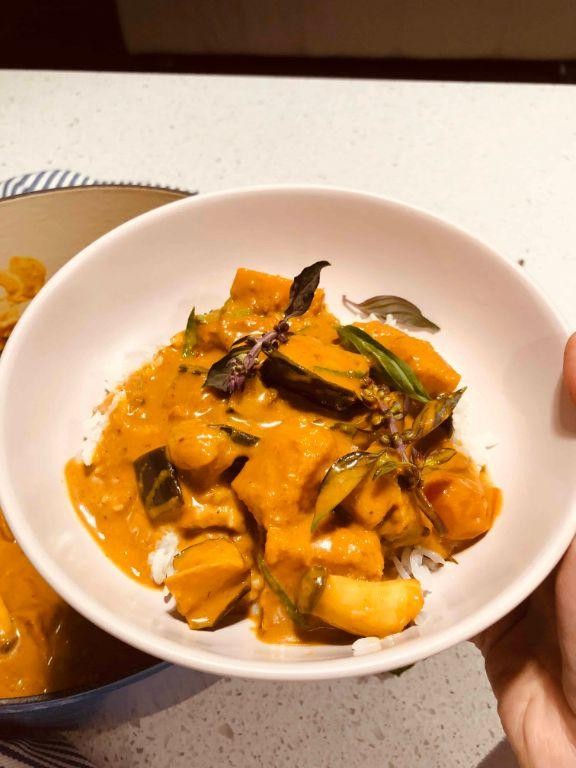
Curling steam rises from the pot as I stir, each swirl releasing memories of rainy afternoons and the comfort that comes from making something beautiful from scratch. Creating this yellow curry paste feels like painting with spices, blending earthy turmeric with the gentle heat of dried chilies until the kitchen smells like sunshine and warmth.
Ingredients
– 1 cup dried yellow chilies (I like to use guajillo for their mild fruity flavor)
– ½ cup chopped lemongrass, tough outer layers removed (the tender white part is what we want)
– ¼ cup chopped galangal (fresh makes all the difference here)
– 3 tablespoons chopped turmeric root (wear gloves—this stains everything yellow)
– 4 large shallots, quartered (they add such lovely sweetness)
– 8 garlic cloves, peeled (I always use fresh, never powdered)
– 2 teaspoons coriander seeds (toasting them first brings out their citrusy notes)
– 1 teaspoon cumin seeds
– ½ teaspoon white peppercorns (black works too, but white gives cleaner heat)
– 3 tablespoons vegetable oil (a neutral oil lets the spices shine)
– 2 tablespoons shrimp paste (this is the secret umami bomb)
– ¼ cup water, plus more as needed
Instructions
1. Place dried yellow chilies in a medium bowl and cover completely with hot water, soaking for 20 minutes until softened.
2. While chilies soak, heat a dry skillet over medium heat and toast coriander seeds, cumin seeds, and white peppercorns for 2-3 minutes until fragrant.
3. Transfer toasted spices to a spice grinder and pulse until finely ground, about 30 seconds.
4. Drain soaked chilies, discarding the water, and remove stems and seeds.
5. Combine soaked chilies, lemongrass, galangal, turmeric, shallots, garlic, ground spices, vegetable oil, shrimp paste, and ¼ cup water in a blender.
6. Blend on high speed for 2 minutes, scraping down sides with a spatula, until a smooth paste forms.
7. If paste is too thick, add additional water 1 tablespoon at a time and blend for another 30 seconds until desired consistency is reached.
8. Transfer curry paste to an airtight jar and refrigerate immediately. Lasting warmth fills the kitchen long after the blending stops, this golden paste carrying layers of earthy turmeric and subtle heat that meld together like old friends. Let it transform coconut milk into velvet sauce, or rub it generously over chicken before roasting—each spoonful holds the quiet magic of homemade things.
Versatile Madras Curry Paste
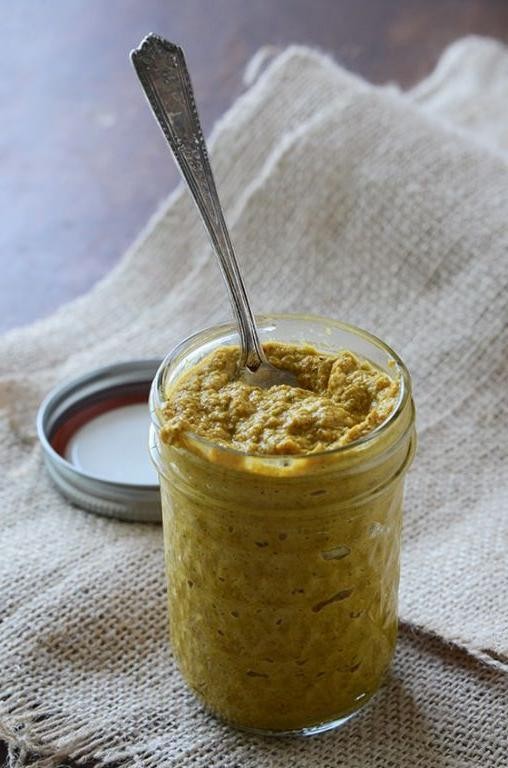
Holding this jar of homemade Madras curry paste feels like cupping warmth in my hands, the deep amber color promising layers of flavor that store-bought versions simply can’t capture. I love making a big batch on quiet afternoons when the kitchen fills with the earthy scent of toasted spices and fresh aromatics. This paste becomes the soul of so many meals throughout the week, from quick vegetable stir-fries to slow-simmered chicken dishes.
Ingredients
– 1 cup dried Kashmiri chilies (I remove most seeds for milder heat, but keep a few for depth)
– ½ cup coriander seeds (toasting these first makes all the difference)
– ¼ cup cumin seeds (their earthy warmth forms the foundation)
– 2 tablespoons fennel seeds (I love the subtle sweetness they bring)
– 1 tablespoon black peppercorns (freshly cracked releases more aroma)
– 2 teaspoons fenugreek seeds (just enough for that distinctive curry house flavor)
– 8 medium garlic cloves (peeled and slightly crushed)
– 3-inch piece fresh ginger (peeled and roughly chopped – I keep mine in the freezer for easy grating)
– ½ cup white vinegar (this preserves the paste beautifully)
– 2 teaspoons salt (I use fine sea salt for even distribution)
– ¼ cup water (room temperature helps everything blend smoothly)
Instructions
1. Heat a dry skillet over medium heat for 2 minutes until a water droplet sizzles immediately.
2. Add coriander seeds and toast for 90 seconds, shaking the pan constantly until they darken slightly and release a nutty aroma.
3. Transfer toasted coriander seeds to a plate to prevent burning.
4. Repeat toasting process separately with cumin seeds for 60 seconds until fragrant.
5. Toast fennel seeds for 45 seconds until lightly golden.
6. Toast black peppercorns and fenugreek seeds together for 75 seconds until you smell their sharp fragrance.
7. Combine all toasted spices in a spice grinder and pulse 8-10 times until coarsely ground.
8. Place dried Kashmiri chilies in a heatproof bowl and cover with boiling water, soaking for 20 minutes until softened.
9. Drain chilies thoroughly, pressing out excess water with the back of a spoon.
10. Combine soaked chilies, ground spices, garlic, ginger, vinegar, salt, and water in a blender.
11. Blend on high speed for 3 minutes, scraping down sides twice, until a smooth paste forms.
12. Transfer paste to a clean glass jar, pressing down to remove air pockets.
13. Store in refrigerator where it will keep for 3 weeks. Now this deep crimson paste carries the warmth of toasted spices balanced by ginger’s sharpness and vinegar’s bright acidity. Nothing compares to stirring a spoonful into coconut milk watching it bloom into golden swirls, or rubbing it under chicken skin before roasting until the edges caramelize.
Flavorful Korma Curry Paste
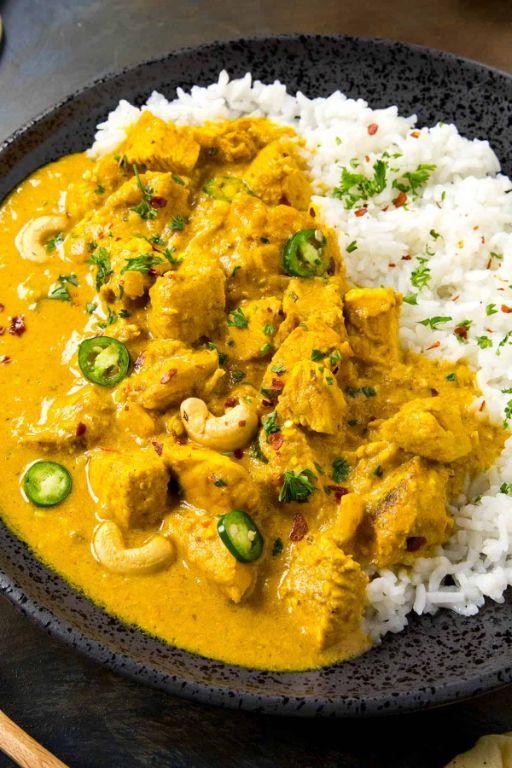
Venturing into the quiet of my kitchen this morning, I find myself drawn to the gentle art of curry-making, where spices whisper stories and patience becomes the secret ingredient. This korma paste feels like a meditation in itself—a slow unfolding of flavors that will later bloom in whatever dish they grace.
Ingredients
– 1 cup raw cashews, which I always soak overnight for that impossibly creamy texture
– 3 tablespoons coconut oil, my favorite for its subtle tropical note
– 1 large yellow onion, roughly chopped—I find the sweetness balances the spices beautifully
– 4 garlic cloves, smashed (I leave the skins on while roasting for protection)
– 1-inch piece of fresh ginger, peeled and sliced
– 2 tablespoons coriander seeds, lightly toasted just until fragrant
– 1 teaspoon cumin seeds, which I toast alongside the coriander for depth
– 1/2 teaspoon turmeric powder, that golden hue that stains my wooden spoon with memories
– 1/4 teaspoon cayenne pepper, just enough warmth to tingle without overwhelming
– 1/2 cup water, at room temperature to help everything blend smoothly
Instructions
1. Preheat your oven to 375°F and line a small baking sheet with parchment paper.
2. Spread the chopped onion and garlic cloves (still in their skins) evenly on the prepared baking sheet.
3. Roast for 25 minutes exactly, until the onion edges are lightly caramelized and the garlic feels soft when pressed.
4. While the vegetables roast, place a small dry skillet over medium-low heat for 2 minutes to warm.
5. Add coriander and cumin seeds to the warm skillet, toasting for 90 seconds while shaking the pan constantly until you smell their nutty aroma.
6. Transfer the toasted seeds immediately to a spice grinder and pulse 5 times until coarsely ground.
7. Drain the soaked cashews thoroughly, giving them a gentle shake in the colander.
8. Combine roasted vegetables (peel the garlic now), ground spices, ginger, turmeric, cayenne, and drained cashews in a blender.
9. Pour in the 1/2 cup water and blend on high speed for 2 full minutes, scraping down the sides once halfway through.
10. Heat coconut oil in the same skillet over medium heat until it shimmers, about 1 minute.
11. Carefully add the blended paste and cook for 8 minutes, stirring constantly with a wooden spoon until it darkens slightly and pulls away from the pan sides.
12. Remove from heat and let cool completely before transferring to an airtight jar. Using room temperature water prevents the blender from creating a pasty texture, toasting whole spices right before grinding unlocks their essential oils, and roasting garlic in its skin keeps it from burning while concentrating its sweetness. Unfolding from the jar days later, this paste will have deepened into something velvety and complex—the cashews lending a creamy weight that carries the toasted spices through steamed vegetables or chicken. Sometimes I thin it with yogurt for a quick marinade, watching it cling to cauliflower florets like golden lace.
Tangy Indonesian Rendang Paste
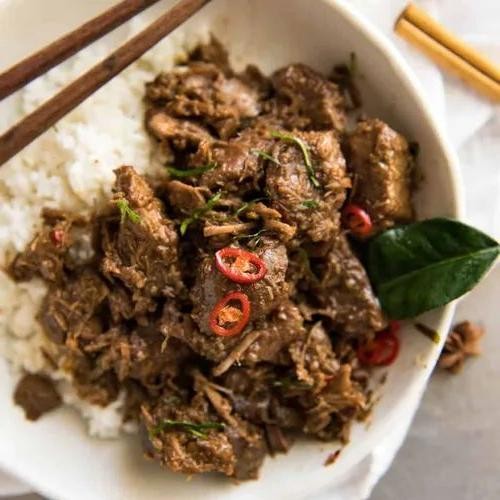
Zestful memories of my first encounter with Indonesian cuisine come flooding back whenever I make this rendang paste. There’s something quietly magical about toasting spices until they release their hidden stories, filling the kitchen with whispers of faraway places. Today, I’m sharing my version—a deeply aromatic, tangy paste that transforms simple ingredients into something extraordinary.
Ingredients
– 1 cup dried red chilies, stems removed (I like to soak these first to soften their fiery edge)
– ½ cup chopped shallots (their gentle sweetness balances the heat beautifully)
– 3 large garlic cloves, peeled (fresh and firm, never sprouted)
– 2-inch piece of fresh ginger, peeled and roughly chopped (the knobbier, the more flavorful)
– 1 lemongrass stalk, tough outer layers removed and tender part sliced (this bright, citrusy note is non-negotiable)
– 1 tablespoon ground turmeric (I prefer freshly ground for its vibrant color and earthiness)
– 2 teaspoons ground coriander (toasted lightly beforehand to awaken its floral notes)
– 1 teaspoon salt (fine sea salt dissolves evenly into the paste)
– 2 tablespoons vegetable oil (a neutral oil lets the spices shine without competing)
– 2 tablespoons fresh lime juice (squeezed just before using for that essential tangy kick)
Instructions
1. Place the dried red chilies in a heatproof bowl and cover them with boiling water; let them soak for 20 minutes until softened.
2. Drain the chilies thoroughly and transfer them to a blender or food processor.
3. Add the chopped shallots, peeled garlic cloves, chopped ginger, sliced lemongrass, ground turmeric, ground coriander, and salt to the blender.
4. Pour in the vegetable oil and fresh lime juice.
5. Blend the mixture on high speed for 2–3 minutes, scraping down the sides once, until it forms a completely smooth, thick paste. (Tip: If the paste is too thick, add 1 tablespoon of water to help it blend evenly.)
6. Heat a large, dry skillet over medium heat for 2 minutes until warm to the touch.
7. Transfer the blended paste to the skillet and cook it over medium-low heat, stirring constantly with a wooden spoon, for 15–18 minutes. (Tip: Keep the heat low to prevent burning—the paste should darken slightly and release a rich, toasted aroma.)
8. Continue stirring until the paste thickens noticeably, pulls away from the sides of the skillet, and the oil begins to separate at the edges.
9. Remove the skillet from the heat and let the paste cool completely to room temperature, about 30 minutes. (Tip: Cooling it fully helps the flavors meld and intensifies the tanginess.)
10. Transfer the cooled paste to an airtight glass jar and store it in the refrigerator for up to 2 weeks.
Pungent and complex, this paste forms a velvety base that clings lovingly to meats or vegetables, its tangy undertones cutting through the richness. I love smearing it thickly on chicken before roasting, or stirring a spoonful into coconut milk for a quick, fragrant curry. However you use it, it brings a piece of my kitchen soul to your table.
Savory Jamaican Curry Paste
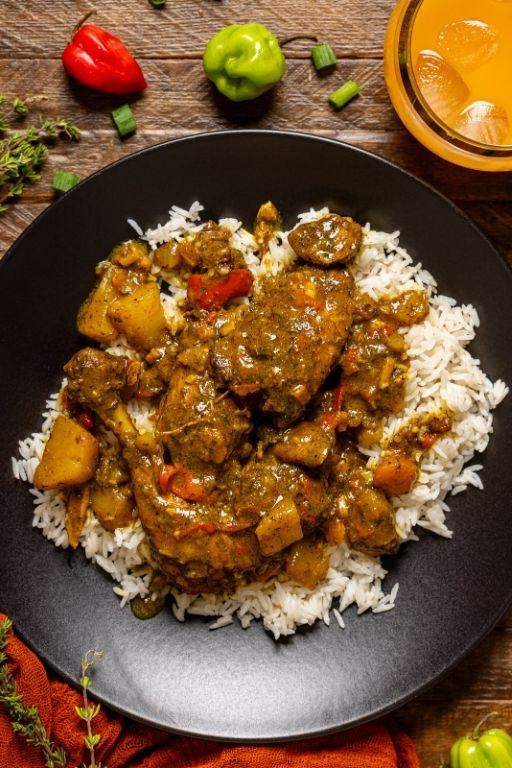
Wandering through my spice cabinet this morning, I found myself drawn to the warm, golden hues of turmeric and curry powder, remembering how this simple paste transforms ordinary meals into vibrant Jamaican feasts. There’s something quietly magical about blending these spices by hand, each scent telling a story of sun-sopped islands and bustling market stalls.
Ingredients
– 2 tablespoons coconut oil (I love how it adds a subtle tropical sweetness)
– 1 medium yellow onion, finely chopped (I always let mine sit for 10 minutes after chopping to deepen the flavor)
– 4 cloves garlic, minced (freshly crushed releases the most aromatic oils)
– 1 tablespoon freshly grated ginger (the knobbier the root, the more potent it seems)
– 2 tablespoons Jamaican curry powder (my favorite brand has a hint of allspice)
– 1 teaspoon ground turmeric (it stains everything, but the earthy depth is worth it)
– 1 scotch bonnet pepper, seeds removed and minced (handle with care—I wear gloves to avoid surprises)
– 1/2 cup vegetable broth (low-sodium lets the spices shine)
– 1 tablespoon fresh lime juice (a squeeze right at the end brightens everything up)
– 1/4 teaspoon sea salt (I prefer fine-grain for even distribution)
Instructions
1. Heat 2 tablespoons coconut oil in a medium skillet over medium-low heat until it shimmers, about 2 minutes.
2. Add 1 finely chopped yellow onion and sauté for 8–10 minutes, stirring occasionally, until translucent and lightly golden at the edges.
3. Stir in 4 minced garlic cloves and 1 tablespoon grated ginger, cooking for 1 minute until fragrant but not browned.
4. Sprinkle 2 tablespoons Jamaican curry powder and 1 teaspoon turmeric over the onion mixture, toasting for 30 seconds to awaken the spices.
5. Mix in 1 minced scotch bonnet pepper and cook for another 30 seconds, coating it evenly with the spiced oil.
6. Pour in 1/2 cup vegetable broth, scraping any browned bits from the skillet bottom with a wooden spoon.
7. Simmer the mixture uncovered for 5–7 minutes, stirring occasionally, until the liquid reduces by half and thickens slightly.
8. Remove the skillet from heat and let it cool for 5 minutes to prevent splattering.
9. Transfer the mixture to a blender, add 1 tablespoon lime juice and 1/4 teaspoon sea salt, and blend on high for 1–2 minutes until completely smooth.
10. Scrape the paste into an airtight glass jar, pressing it down to remove air pockets.
Using this paste feels like unfolding a secret map—each spoonful layers earthy turmeric with the gentle heat of scotch bonnet, creating a paste that clings lovingly to chickpeas or chicken. I’ve swirled it into coconut milk for a quick curry sauce or spread it under the skin of roasted vegetables, where it caramelizes into something deeply fragrant and wholly comforting.
Homestyle Bengali Curry Paste
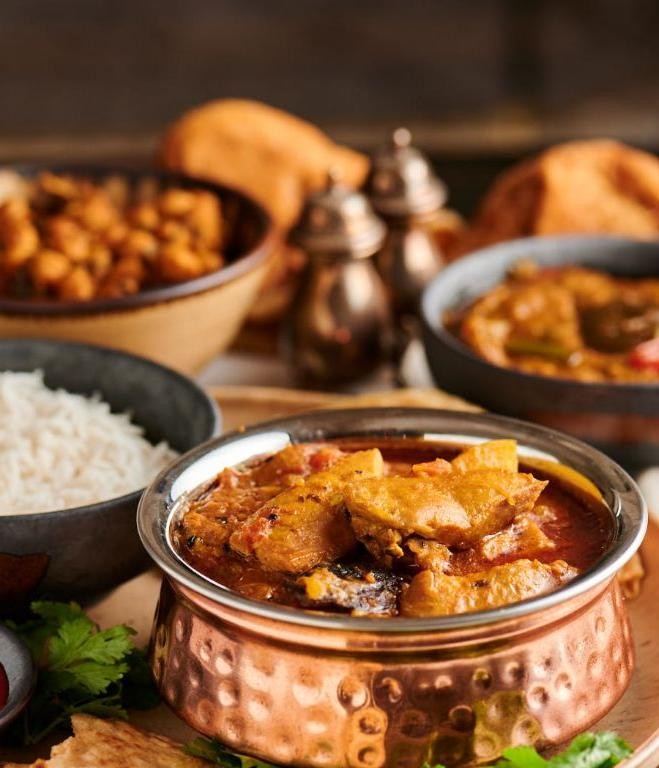
Mellow afternoons like this always draw me back to the kitchen, where the slow, rhythmic process of making curry paste feels like meditation. There’s something deeply comforting about transforming simple spices into the foundation of so many cherished meals, each batch carrying memories of family kitchens and shared stories.
Ingredients
– 1 cup yellow onions, roughly chopped (I find sweet onions work beautifully here)
– 4 large garlic cloves, peeled (fresh, firm cloves release the best aroma)
– 2-inch piece of fresh ginger, peeled and sliced (I keep mine in the freezer for easy grating)
– 2 fresh green chilies, stems removed (remove seeds if you prefer milder heat)
– 1 tablespoon coriander seeds (toasting them first unlocks their citrusy notes)
– 1 teaspoon cumin seeds (their earthy warmth is essential)
– ½ teaspoon turmeric powder (this vibrant yellow stains everything, so wear an apron)
– 3 tablespoons vegetable oil (a neutral oil lets the spices shine)
– ½ cup water, divided (room temperature blends more smoothly)
– 1 teaspoon salt (I use fine sea salt for even distribution)
Instructions
1. Heat a dry skillet over medium heat for 2 minutes until warm to the touch.
2. Add coriander seeds and cumin seeds to the skillet, toasting for 90 seconds while shaking the pan constantly until fragrant and slightly darkened.
3. Transfer toasted seeds immediately to a spice grinder and grind into a fine powder, about 30 seconds of pulsing.
4. Combine chopped onions, garlic cloves, ginger slices, and green chilies in a blender jar.
5. Add the ground spice mixture, turmeric powder, and salt to the blender.
6. Pour ¼ cup water into the blender to help with initial blending.
7. Blend on high speed for 2 minutes, scraping down the sides with a spatula halfway through, until a coarse paste forms.
8. Heat vegetable oil in a small saucepan over medium-low heat until it shimmers, about 3 minutes.
9. Carefully add the spice paste to the hot oil, stirring immediately with a wooden spoon.
10. Cook the paste for 8-10 minutes, stirring constantly, until the oil separates and rises to the surface and the raw onion smell disappears.
11. Add remaining ¼ cup water and continue cooking for another 5 minutes, until the paste thickens and darkens slightly.
12. Remove from heat and let cool completely before transferring to an airtight container.
Golden and aromatic, this paste carries the deep, earthy warmth of toasted spices balanced by the fresh sharpness of ginger and garlic. I love stirring a spoonful into lentil soups or spreading it beneath chicken before roasting—it transforms simple ingredients into something extraordinary, each bite layered with complexity that only develops when you take your time.
Warm Moroccan Curry Paste
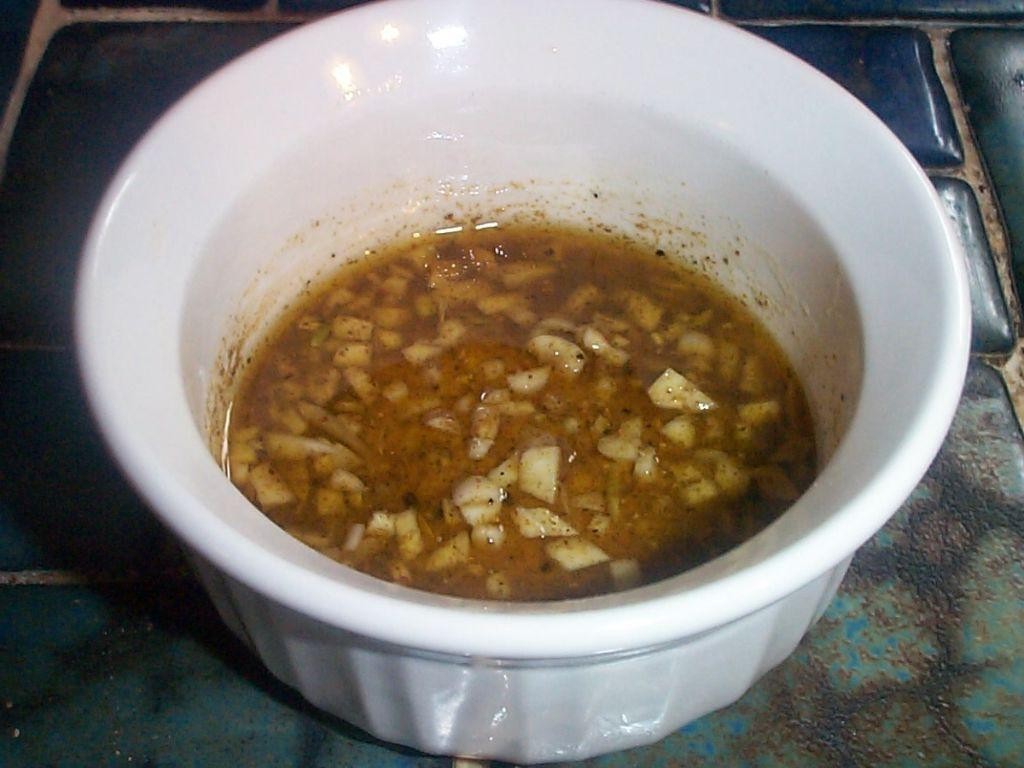
Remembering the first time I tasted this curry paste in a tiny Marrakech stall, how its warmth seemed to hold the entire spice market in one spoonful—it’s that feeling I try to recreate in my kitchen on quiet afternoons, when the light slants just right and time feels expansive.
Ingredients
– 1 cup dried red chilies (I like a mix of guajillo and ancho for depth, but any mild dried chilies will do)
– 3 tbsp coriander seeds (toasting these first makes all the difference)
– 2 tbsp cumin seeds (their earthy scent fills the kitchen beautifully)
– 1 tbsp fennel seeds (I always add a pinch extra for a subtle sweetness)
– 6 garlic cloves (fresh and firm, peeled)
– 1/4 cup extra virgin olive oil (my go-to for its fruity notes)
– 1 tsp fine sea salt (it helps balance the spices)
Instructions
1. Place a dry skillet over medium heat and add coriander seeds, toasting for 2–3 minutes until fragrant and slightly darkened.
2. Transfer toasted coriander seeds to a spice grinder, then repeat toasting process separately with cumin seeds for 2 minutes and fennel seeds for 90 seconds.
3. Combine all toasted seeds in the grinder and pulse until a coarse powder forms, about 10–12 pulses.
4. Stem dried chilies and shake out seeds, then tear chilies into 1-inch pieces with your hands.
5. Heat olive oil in the same skillet over medium-low heat until it shimmers, about 2 minutes.
6. Add garlic cloves and cook for 3–4 minutes, stirring frequently, until golden at the edges but not browned.
7. Add chili pieces to the skillet and toast for 90 seconds, pressing down gently with a spatula until slightly blistered.
8. Transfer chilies, garlic, and any remaining oil to a blender along with the ground spice mixture and salt.
9. Blend on high speed for 2–3 minutes, scraping down sides twice, until a smooth, thick paste forms.
You’ll notice the paste develops a velvety texture that clings to spoons, with layers of earthy cumin giving way to the chilies’ gentle heat. I love swirling a spoonful into lentil soup or spreading it beneath chicken before roasting—it seems to deepen everything it touches.
Spicy Korean Curry Paste
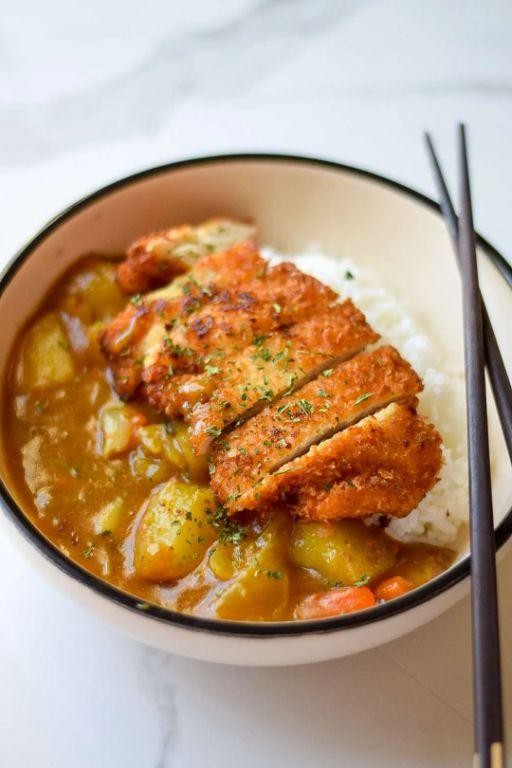
Cradling a warm bowl on quiet evenings has become my small ritual, the steam carrying scents that feel both foreign and familiar. Today I’m sharing my version of Korean curry paste, a recipe born from many trial batches and the gentle heat that lingers just right. It’s become my go-to for adding depth to weeknight meals when I crave something comforting yet vibrant.
Ingredients
– 1 cup gochugaru (Korean red pepper flakes) – I prefer the medium-coarse grind for better texture
– ¼ cup doenjang (Korean fermented soybean paste) – this adds such wonderful umami depth
– 3 tablespoons minced garlic – fresh cloves make all the difference here
– 2 tablespoons grated ginger – I keep mine frozen for easy grating
– ¼ cup soy sauce – the regular kind works perfectly, no need for low-sodium
– 2 tablespoons rice vinegar – that subtle tang balances everything so nicely
– 1 tablespoon sesame oil – toasting the seeds myself feels extra special
– 1 tablespoon honey – local wildflower honey is my favorite for its floral notes
Instructions
1. Measure 1 cup gochugaru into a medium mixing bowl, breaking up any clumps with your fingers.
2. Add ¼ cup doenjang to the bowl, using a spatula to incorporate it evenly with the gochugaru.
3. Mix in 3 tablespoons minced garlic, stirring until no white streaks remain.
4. Incorporate 2 tablespoons grated ginger, making sure it’s distributed throughout the mixture.
5. Pour in ¼ cup soy sauce gradually while stirring constantly to prevent clumping.
6. Add 2 tablespoons rice vinegar, continuing to mix until the paste becomes smooth.
7. Drizzle in 1 tablespoon sesame oil, folding it in to help emulsify the ingredients.
8. Stir in 1 tablespoon honey until fully dissolved and the paste reaches a spreadable consistency.
9. Transfer the finished paste to an airtight container, pressing down to remove air pockets.
10. Refrigerate for at least 4 hours before using to allow the flavors to meld properly.
Resting in the fridge transforms this paste into something magical – the heat softens into a warm glow while the fermented notes deepen. I love swirling it into simmering stews where it melts into the broth, or thinning it with a little sesame oil for a quick marinade. The texture becomes beautifully velvety after resting, clinging to vegetables and meat with its complex, savory-sweet character.
Exotic Burmese Curry Paste
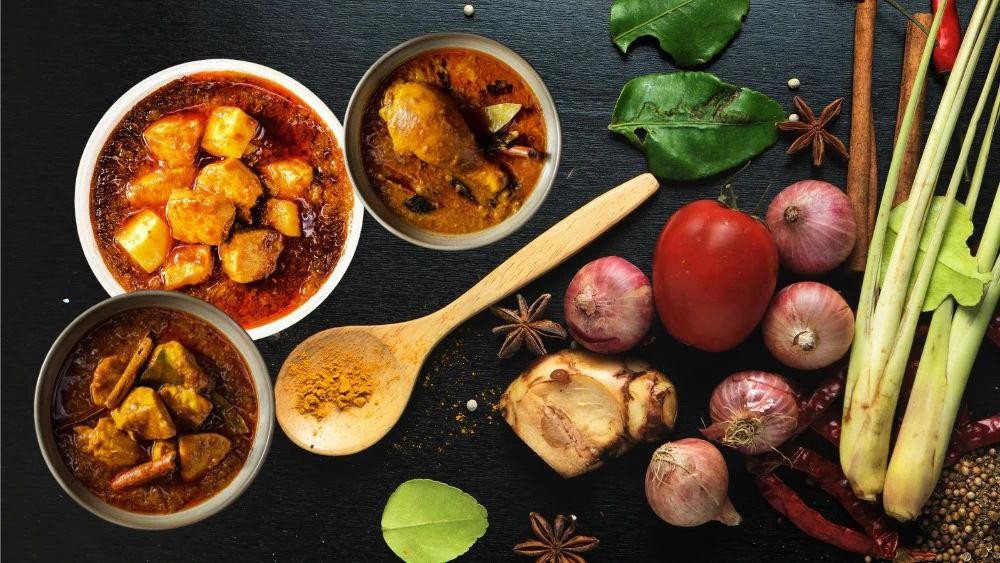
Unfolding the layers of Burmese cuisine feels like discovering a secret world—this curry paste, with its complex harmony of spices and aromatics, has become my quiet kitchen companion through many reflective evenings, transforming simple meals into something quietly extraordinary.
Ingredients
– 1 cup chopped yellow onions (I find their sweetness balances the heat perfectly)
– 4 garlic cloves, minced (freshly crushed releases the most flavor)
– 2-inch piece fresh ginger, peeled and grated (I keep mine frozen for easier grating)
– 2 dried red chilies, stems removed (soaking them in warm water for 10 minutes prevents burning)
– 1 tbsp ground turmeric (this vibrant powder stains everything, so I wear an apron)
– 1 tsp paprika (smoked paprika adds a lovely depth)
– 1/2 cup water, at room temperature (cold water can shock the ingredients)
– 2 tbsp vegetable oil (a neutral oil lets the spices shine)
Instructions
1. Combine the chopped yellow onions, minced garlic cloves, grated ginger, soaked dried red chilies, ground turmeric, and paprika in a blender.
2. Pour in the room temperature water to help the ingredients blend smoothly.
3. Blend on high speed for 2 minutes, scraping down the sides with a spatula halfway through, until a thick, uniform paste forms.
4. Heat the vegetable oil in a skillet over medium heat until it shimmers, about 2 minutes.
5. Add the blended paste to the hot oil and cook for 8–10 minutes, stirring constantly with a wooden spoon, until the raw aroma disappears and the oil starts to separate from the paste.
6. Remove the skillet from the heat and let the paste cool completely to room temperature, about 20 minutes, before transferring to an airtight jar.
Perfectly velvety and deeply aromatic, this paste clings to meats and vegetables with a warmth that builds slowly. I love stirring a spoonful into coconut milk for a quick curry or smearing it under chicken skin before roasting—it’s the kind of humble magic that makes weeknight dinners feel like small celebrations.
Conclusion
Deliciously diverse, these 20 curry paste recipes offer endless inspiration for your kitchen adventures. From quick weeknight meals to impressive dinner party dishes, there’s something for every taste and occasion. We’d love to hear which recipes become your favorites—drop us a comment below! Don’t forget to pin your top picks to Pinterest so you can easily find them later. Happy cooking!


